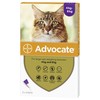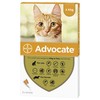Advocate for Cats
Advocate Spot-On Solution for Cats & Ferrets is indicated for the treatment of cats and ferrets that are at risk from, or already suffering from mixed parasitic infections. It is particularly effective against flea infestations and their larvae, roundworms, hookworms, whipworms, ear mites and sarcoptic mange. It can also be effective in preventing heartworm disease.
Advocate for Cats is presented as a clear yellowish to brownish solution in single-use plastic pipettes for dermal (spot-on) treatment.
Advocate Spot-On Solution for Large Cats
From:£12.65 to… £22.36Advocate Spot-On Solution for Large Cats is a broad spectrum combination treatment for cats weighing between 4 and 8kg, that are suffering from, or at risk from, mixed parasitic infections....[More info]
Advocate Spot-On Solution for Small Cats & Ferrets
From:£12.35 to… £21.35Advocate Spot-On Solution for Small Cats & Ferrets is a broad spectrum combination treatment for cats under 4kg and ferrets that are suffering from, or at risk from, mixed parasitic...[More info]
Dosage and administration
The recommended minimum doses for cats are 10 mg/kg body weight imidacloprid and 1.0 mg/kg body weight moxidectin, equivalent to 0.1ml/kg body weight Advocate for cats.
Dosage schedule for ferrets: one pipette of Advocate spot-on solution for small cats and ferrets (0.4 ml) should be administered per animal. Do not exceed the recommended dose.
The treatment schedule for all species should be based on individual veterinary diagnosis and on the local epidemiological situation.
Flea treatment and prevention (Ctenocephalides felis) (Cats)
One treatment prevents future flea infestation for 4 weeks. Existing pupae in the environment may emerge for 6 weeks or longer after treatment is initiated, depending upon climatic conditions. Therefore, it may be necessary to combine Advocate treatment with environmental treatments aimed at breaking the flea life cycle in the surroundings. This can result in a more rapid reduction in the household flea population. The product should be administered at monthly intervals when used as part of a treatment strategy for flea allergy dermatitis.
Flea treatment and prevention (Ctenocephalides felis) (Ferrets)
One treatment prevents future flea infestation for 3 weeks. Under heavy flea pressure it may be necessary to repeat the dose after 2 weeks.
Treatment of ear mite infestation (Otodectes cynotis) (Cats)
A single dose of the product should be administered. A further veterinary examination 30 days after treatment is recommended as some animals may require a second treatment. Do not apply directly to the ear canal.
Treatment of notoedric mange (Notoedres cati) (Cats)
A single dose of the product should be administered.
Treatment of the lungworm Eucoleus aerophilus (syn. Capillaria aerophila) (adults) (Cats)
A single dose of the product should be administered.
Prevention of Aelurostrongylus abstrusus (Cats)
The product should be administered monthly.
Treatment of Aelurostrongylus abstrusus (Cats)
Advocate should be administered monthly for three consecutive months.
Treatment of the eye worm Thelazia callipaeda (adults) (Cats)
A single dose of the product should be administered.
Prevention of heartworm disease (D.immitis) (Cats & Ferrets)
Cats and ferrets in areas endemic for heartworm, or those which have travelled to endemic areas, may be infected with adult heartworms. Therefore prior to treatment with Advocate, the advice provided in Contra-Indications and Warnings etc should be considered. For prevention of heartworm disease, the product must be applied at regular monthly intervals during the time of the year when mosquitoes (the intermediate hosts which carry and transmit D. immitis larvae) are present. The product may be administered throughout the year. The first dose may be given after first possible exposure to mosquitoes, but not more than one month after this exposure. Treatment should continue at regular monthly intervals until 1 month after the last exposure to mosquitoes. To establish a treatment routine, it is recommended that the same day or date be used each month. When replacing another heartworm preventative product in a heartworm prevention programme, the first treatment with Advocate must be given within 1 month of the last dose of the former medication.
In non-endemic areas there should be no risk of animals having heartworm. Therefore, they can be treated without special precautions.
Roundworm and hookworm treatment (Toxocara cati and Ancylostoma tubaeforme)(Cats)
In areas endemic for heartworm, monthly treatment may significantly reduce the risk of re-infection caused by the respective roundworms and hookworms. In areas non-endemic for heartworm, the product can be used as part of a seasonal prevention programme against fleas and gastrointestinal nematodes.
Method of administration
For external use only.
Remove one pipette from the package. Then hold the pipette in an upright position, and twist and pull off the cap. Reverse the cap and use it to twist and remove the seal from the pipette, as shown.
Cats and Ferrets
Part the fur on the animal's neck at the base of the skull until the skin is visible. Place the tip of the pipette on the skin and squeeze the pipette firmly several times to empty its contents directly onto the skin. Application at the base of the skull will minimise the opportunity for the animal to lick the product. Apply only to undamaged skin.
Use During Pregnancy and Lactation
The safety of the veterinary medicinal product has not been established during pregnancy and lactation in the target species. Therefore, the use of the product is not recommended in animals intended for breeding or during pregnancy and lactation.
Contra-indications, warnings, etc
Do not use in kittens under 9 weeks of age.
Treatment of cats weighing less than 1 kg, and ferrets weighing less than 0.8 kg should be based on a risk-benefit assessment.
Do not use in the cases of hypersensitivity to the active substances or to any of the excipients.
There is limited experience on the use of the product in sick and debilitated animals, thus the product should only be used based on a risk-benefit assessment for these animals.
For cats, the corresponding "Advocate spot-on solution for cat" product, which contains 100 mg/ml imidacloprid and 10 mg/ml moxidectin, must be used.
For ferrets: Do not use Advocate for large cats (0.8ml) or Advocate for dogs (any size), only "Advocate for small cats and ferrets" (0.4 ml) must be used. The product's efficacy has not been tested in ferrets weighing over 2 kg and therefore the duration of effect might be shorter in these animals.
Do not use on canaries.
Do not apply in the mouth, in the eyes or the ears of the animal.
Care should be taken that the product is not ingested by animals and does not come into contact with the eyes or mouth of the recipient and/or other animals.
Consider carefully the correct application method described in the 'Method of Application' section, especially that the product should be applied to the site specified in order to minimise the risk for the animal to lick the product.
Do not allow recently treated animals to groom each other. Do not allow treated animals to come into contact with untreated animals until the application site is dry.
When the product is applied in 3 to 4 separate spots (see the 'Method of Application' section), specific care should be taken to prevent the animal licking the application sites.
During treatment with Advocate no other antiparasitic macrocyclic lactone should be administered.
The product tastes bitter. Salivation may occasionally occur if the animal licks the application site immediately after treatment. This is not a sign of intoxication and disappears within some minutes without treatment. Correct application will minimise licking of the application site.
In case of accidental oral uptake, symptomatic treatment should be administered. There is no known specific antidote. The use of activated charcoal may be beneficial. After accidental oral ingestion (e.g. licking at the site of application) or overdose, neurological signs (most of which are transient) such as ataxia, generalised tremors, ocular signs (dilated pupils, little pupillary reflex, nystagmus), abnormal respiration, salivation and vomiting may be observed in very rare cases.
The use of the product may result in transient pruritus in the animal. Vomiting can occur on rare occasions. In cats greasy fur and erythema can occur on rare occasions. These signs disappear without further treatment. If the animal licks the application site after treatment, neurological signs (most of which are transient) may be observed in very rare cases (see below). The product may, in rare cases cause local hypersensitivity reactions. The product may in very rare cases cause at the application site a sensation resulting in transient behavioural changes such as lethargy, agitation, and inappetence.
The frequency of adverse reactions is defined using the following convention:
- very common (more than 1 in 10 animals treated displaying adverse reaction(s))
- common (more than 1 but less than 10 animals in 100 animals treated)
- uncommon (more than 1 but less than 10 animals in 1,000 animals treated)
- rare (more than 1 but less than 10 animals in 10,000 animals treated)
- very rare (less than 1 animal in 10,000 animals treated, including isolated reports).
Up to 10 times the recommended dose was tolerated in cats with no evidence of adverse effects or undesirable clinical signs.
The product was administered to kittens at up to 5 times the recommended dose, every 2 weeks for 6 treatments, and there were no serious safety concerns. Transient mydriasis, salivation, vomiting and transient rapid respiration were observed.
The product was administered to ferrets at 5 times the recommended dose, every 2 weeks for 4 treatments, and there was no evidence of adverse effects or undesirable clinical signs.
It is recommended that cats and ferrets living in, or travelling to areas endemic for heartworm are treated monthly with the product to protect them from heartworm disease. Whilst the accuracy of diagnosis of heartworm infection is limited, it is recommended that attempts be made to check the heartworm status of any cat and ferret aged over 6 months, before beginning prophylactic treatment, as use of the product on cats or ferrets which have adult heartworms may cause serious adverse effects, including death. If adult heartworm infection is diagnosed, the infection should be treated in accordance with current scientific knowledge.
Efficacy against adult Dirofilaria repens has not been tested under field conditions.
In certain individual cats Notoedres cati infestation may be severe. In these severe cases concomitant supportive treatment is necessary as treatment with the product alone may not be sufficient to prevent death of the animal.
Imidacloprid is toxic for birds, especially canaries.
No interactions between Advocate and routinely used veterinary medicinal products or medical or surgical procedures have been observed.
Safety of Advocate when administered on the same day as an adulticide to remove adult heartworms has not been evaluated.
Brief contact of the animal with water on one or two occasions between monthly treatments is unlikely to significantly reduce the efficacy of the product. However, frequent shampooing or immersion of the animal in water after treatment may reduce the efficacy of the product.
Parasite resistance to any particular class of anthelmintic may develop following frequent, repeated use of an anthelmintic of that class. Therefore, the use of this product should be based on the assessment of each individual case and on local epidemiological information about the current susceptibility of the target species in order to limit the possibility of a future selection for resistance.
The use of the product should be based on the confirmed diagnosis of mixed infection (or risk of infection, where prevention applies) at the same time.
The solvent in Advocate may stain or damage certain materials including leather, fabrics, plastics and finished surfaces. Allow the application site to dry before permitting contact with such materials.

